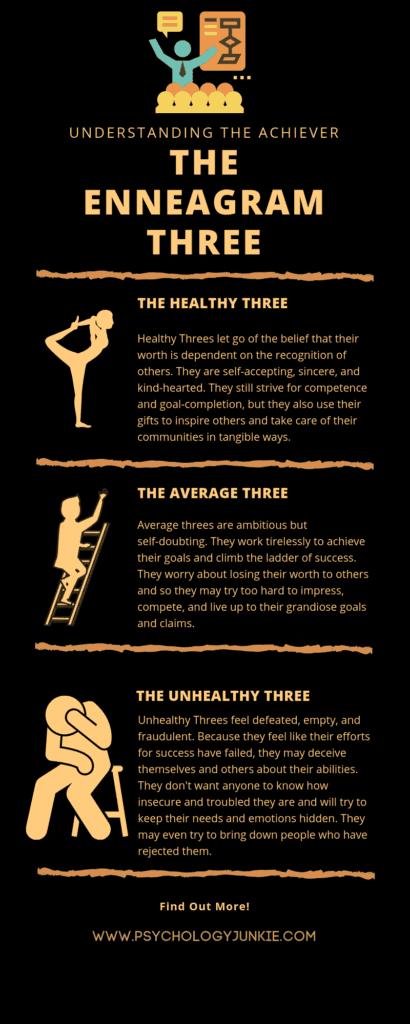Escaping the Trap of Vanity for Enneagram 3s
The Enneagram is a personality system that categorizes individuals into nine distinct types. Each Enneagram type has a unique way of looking at the world and responding to it. If you’ve ever wondered why you have certain motivations and fears you can’t shake, the Enneagram can help. Today’s article will only scratch the surface of the Enneagram; but you can find out much more in our further articles or in the books in the references section of this article. In today’s article, we’re exploring the Enneagram 3, also known as the Achiever. If you’re not sure what your Enneagram type is, you can take our questionnaire here.
Estimated reading time: 6 minutes

An Introduction to the Three:

The Enneagram 3, known as the Achiever, is a member of the heart triad in the Enneagram. Other heart types include the Two and the Four. Of all three heart types, the Three is the most disconnected from their own feelings. While Threes crave love and struggle with shame like all heart types, they tend to push away their feelings. They crave recognition as successful, capable, and efficient individuals, and desire to be worthy and valued. Thus, they actively pursue success, often suppressing their emotions because they fear they’ll get in the way or cause people to doubt them. They fear that acknowledging their own desires will diminish the respect of others, resulting in their emotions being perpetually “boxed up.”
The Fixation of Vanity
The fixation of the 3 is vanity; a deep preoccupation with one’s appearance, accomplishments, and level of success. Threes have a deep, pervasive fear of being inadequate or unsuccessful, which drives them to strive for and maintain an impeccable image. In their pursuit, they may go to great lengths to conceal any aspects of themselves that do not align with this desired image, often adopting a carefully crafted persona that they believe embodies success. However, this relentless drive to maintain an idealized version of themselves can lead to a sense of disconnection, both from their true selves and from others.
“I have terrible social anxiety. I vomit before going to social events. I hate public speaking. But I’m the spokesperson for a big brand and so I have to travel to a lot of events and conferences. I know I have to “fake it until I make it.” I adopt the identity of a confident, strong business woman, step out of my room, plaster on a smile and walk tall. I “become” a powerful, wealthy, confident CEO. I suppress everything that isn’t that person. When I get back to my room, I’m exhausted and a little dizzy. I feel disconnected from myself and vacant inside.”
– An anonymous reader who agreed to tell their story
Threes often experience a profound sense of pain, driven by their longing to be deeply loved and valued for who they are. They yearn to be seen beyond their achievements or the external image they project. However, they don’t feel like they can let their true self out of the box. The validation they receive based on accomplishment and success is fleeting, leaving them with a constant sense that if their true selves were revealed, they would be nothing.
In childhood, Threes often lost themselves in becoming the person they thought their parents or families wanted. They discovered that by achieving, succeeding, and “playing the role” of an accomplished child, they could receive a superficial sense of love and acceptance. Accomplishments got them praise and failure devastated them. Consequently, they internalized the belief that any form of failure was to be avoided at all costs; that they could never let the mask drop. This drive to excel and the constant pursuit of perfection became deeply ingrained in their mindset, shaping their approach to life and the choices they made.
Breaking Free from the Trap of Vanity
Breaking free from a fixation is incredibly difficult. When I give advice here, please don’t think that I’m saying this is easy. Each of these steps may look simple to someone with another Enneagram type, but for a Three this will be much harder. Start small, be gentle with yourself, and know that the pursuit of real joy is worth these struggles.
Self-discovery is one of the most important steps towards healing for Threes. Having spent much of their lives striving to appear successful and boxing up their emotions, Threes often find themselves disconnected from their true selves. To liberate themselves from this fixation, Threes need to embark on the path of self-exploration. This means uncovering their authentic desires, needs, weaknesses, and vulnerabilities. Below are a few ways to begin this process:
- Make time for quiet reflection to get to know yourself. Find a quiet space and journal or meditate to gain insights into your thoughts, emotions, and needs. Start by making five minutes a day for quiet inner reflection, then move up from there.
- Explore and embrace activities that bring you joy and fulfillment beyond work or professional accomplishments. It is crucial to cultivate hobbies and pursue interests that are separate from your career goals. By doing so, you can break free from the mindset of equating your self-worth solely with professional success. Take the time to discover what truly brings you happiness and make it a regular part of your life.
- Cultivate acceptance: Mastering the art of embracing oneself, flaws and all, is key in liberating oneself from vanity. By embracing our imperfections, we unlock the path to inner serenity and self-love. Nurture self-compassion and acknowledge that you are deserving of love and respect, irrespective of your accomplishments. This can be hard at first, but it’s worth it.
One of the next important steps towards healing for Threes is integrating the Six side of their personality type. When Threes become healthy, they capture some of the best qualities of the healthy Six. They still have the drive, energy, and ambition of the Three, but that is paired with a community-conscious hunger to support others, and be supported in turn.
- Work towards a cause bigger than yourself: Engaging in a cause or project that serves others can help shift the focus from yourself to the greater good. This can bring immense satisfaction and fulfillment, lifting you out of the trap of comparison and success-seeking. Volunteer at a local charity, participate in a social justice movement, or mentor someone who could benefit from your advice.
- Actively support the people in your life. Reach out and let them know you care or lend a helping hand to someone in need. Think of ways to regularly nurture your personal relationships, even if it does nothing for you professionally.
- Practice being vulnerable. It’ll feel scary, but start small and be patient with yourself. Vulnerability is challenging for Enneagram 3s in particular because it means admitting imperfection and weakness. However, the benefits far outweigh the risks. Opening up and sharing your innermost thoughts, feelings, and experiences can be liberating; it is in moments of vulnerability that we make genuine connections with others. You can deepen your relationships, become more accepting of yourself, and find true joy and meaning outside of the pursuit of success.
“Coming home for the Three requires facing their feelings, listening to the subtext of their emotional intelligence, and engaging their own hearts without judgment or prejudice. In so doing they can overcome the lie of their identity, “I am what others think or say about me,” and their Childhood Wound – their malformed perception of love, which seems tucked underneath the admiration of others.”
Christopher L. Heuertz, The Sacred Enneagram
Conclusion:
The Enneagram 3 fixation of vanity can be deeply painful and draining. It is an uphill battle to break free from this trap, but it is possible with awareness, willpower, and practice. With patience and self-compassion, Threes can learn to embrace their imperfections and reconnect with their true selves. They can find joy in activities beyond accomplishments or appearances, and they can make genuine connections with others by being vulnerable. The journey to freedom is long, but it is worth taking for the ultimate reward of inner peace and true joy.
Discover more about your Enneagram type and how to get in touch with the best parts of yourself in The Sacred Enneagram by Christopher L. Heuertz
This article contains affiliate links to books on Amazon or courses on Personality Hacker. If you purchase one of these books or courses, I get a small kickback that I can use to pay for hosting and other demands of this site. I only recommend books I love.
Other Articles You Might Enjoy:
21 Signs That You’re an Enneagram 3
7 Struggles of the Enneagram 3 Type
References:
The Enneagram Made Easy by Renee Baron & Elizabeth Wagele (1994, HarperOne)
The Sacred Enneagram by Christopher L. Heuertz (2017, Zondervan Publishing)







